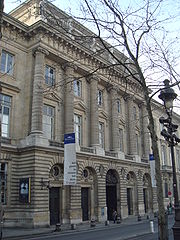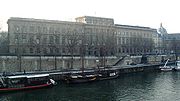
Monnaie de Paris
Encyclopedia


Coin
A coin is a piece of hard material that is standardized in weight, is produced in large quantities in order to facilitate trade, and primarily can be used as a legal tender token for commerce in the designated country, region, or territory....
s as well as producing medal
Medal
A medal, or medallion, is generally a circular object that has been sculpted, molded, cast, struck, stamped, or some way rendered with an insignia, portrait, or other artistic rendering. A medal may be awarded to a person or organization as a form of recognition for athletic, military, scientific,...
s and other similar items. Many ancient coins are housed there. Created in 864
864
Year 864 was a leap year starting on Saturday of the Julian calendar.- Europe :* July 25 – Edict of Pistres: Charles the Bald orders defensive measures against the Vikings....
, it is the oldest French institution.
Building in Paris
A Neoclassical edificeNeoclassical architecture
Neoclassical architecture was an architectural style produced by the neoclassical movement that began in the mid-18th century, manifested both in its details as a reaction against the Rococo style of naturalistic ornament, and in its architectural formulas as an outgrowth of some classicizing...
, the Hôtel de la Monnaie was designed by Jacques-Denis Antoine and built from 1767–1775 on the Left Bank of the Seine
Seine
The Seine is a -long river and an important commercial waterway within the Paris Basin in the north of France. It rises at Saint-Seine near Dijon in northeastern France in the Langres plateau, flowing through Paris and into the English Channel at Le Havre . It is navigable by ocean-going vessels...
. The Monnaie was the first major civic monument undertaken by Antoine, yet shows a high level of ingenuity on the part of the architect. Today it is considered a key example of French Neoclassicism
Neoclassicism
Neoclassicism is the name given to Western movements in the decorative and visual arts, literature, theatre, music, and architecture that draw inspiration from the "classical" art and culture of Ancient Greece or Ancient Rome...
in pre-Revolutionary
French Revolution
The French Revolution , sometimes distinguished as the 'Great French Revolution' , was a period of radical social and political upheaval in France and Europe. The absolute monarchy that had ruled France for centuries collapsed in three years...
Paris. The building is typified by its heavy external rustication
Rustication (architecture)
thumb|upright|Two different styles of rustication in the [[Palazzo Medici-Riccardi]] in [[Florence]].In classical architecture rustication is an architectural feature that contrasts in texture with the smoothly finished, squared block masonry surfaces called ashlar...
and severe decorative treatment. It boasts one of the longest façade
Facade
A facade or façade is generally one exterior side of a building, usually, but not always, the front. The word comes from the French language, literally meaning "frontage" or "face"....
s on the Seine; its appearance has been likened to the Italian palazzo
Palazzo
Palazzo, an Italian word meaning a large building , may refer to:-Buildings:*Palazzo, an Italian type of building**Palazzo style architecture, imitative of Italian palazzi...
tradition. The building, which housed mint workshops, administrative rooms, and residential quarters, wraps around a large interior courtyard
Courtyard
A court or courtyard is an enclosed area, often a space enclosed by a building that is open to the sky. These areas in inns and public buildings were often the primary meeting places for some purposes, leading to the other meanings of court....
. It remains open to the public and includes a numismatics
Numismatics
Numismatics is the study or collection of currency, including coins, tokens, paper money, and related objects. While numismatists are often characterized as students or collectors of coins, the discipline also includes the broader study of money and other payment media used to resolve debts and the...
museum, located within what was once the main foundry
Foundry
A foundry is a factory that produces metal castings. Metals are cast into shapes by melting them into a liquid, pouring the metal in a mold, and removing the mold material or casting after the metal has solidified as it cools. The most common metals processed are aluminum and cast iron...
.
See also
- List of museums in Paris
- Philippe DanfriePhilippe DanfriePhilippe Danfrie the elder , was a designer and maker of mathematical instruments in metal and paper, as well as a type-cutter, engraver, minter of coins and medals, publisher and author. Much is known about Danfrie's life and activities...
- Superintendent of the Mint in the late 16th century.

